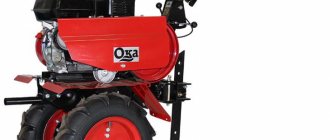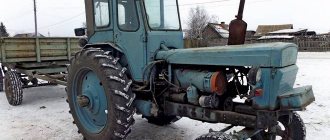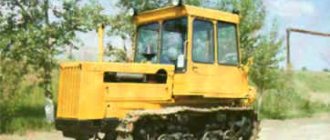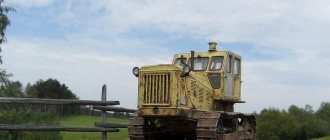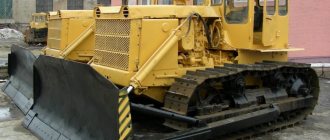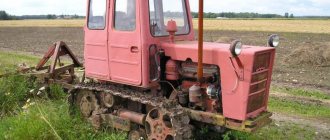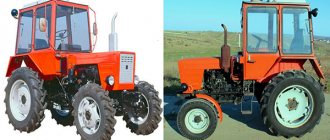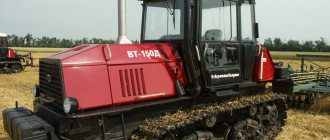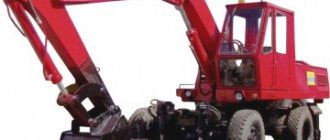- Technical characteristics of the SMD-62 engine
- Features of the YaMZ-236 engine on the T-150
The T-150 and T-150K tractors were developed by engineers of the Kharkov Tractor Plant. This model replaced another original KhTZ development - the T-125, the production of which was discontinued in 1967.
The T-150 was in development for several years and entered mass production in 1971. Initially it was a T-150K model - a tractor on a wheelbase. Since 1974, production of a caterpillar tractor labeled T-150 began.
The principle laid down by KhTZ engineers when developing the T-150 and T-150 K was the maximum unification of these models. Wheeled and tracked tractors have as similar a design as possible, taking into account the different propulsion systems. In this regard, most spare parts and assemblies are marked for the T-150, but it is understood that they are also suitable for the T-150K wheeled tractor.
Engine T-150 SMD-60
The first T-150 tractors had an SMD-60 diesel engine. The motor had a fundamentally different design for that time and was very different from other units for special equipment.
The T-150 SMD-60 engine is a four-stroke, short-stroke engine. It has six cylinders arranged in 2 rows. The engine is turbocharged, has liquid cooling and direct fuel injection systems.
A feature of the engine of the T-150 SMD-60 tractor is that the cylinders are not located opposite each other, but with an offset of 3.6 cm. This was done in order to install the connecting rods of opposite cylinders on one crankpin of the crankshaft.
The configuration of the T-150 SMD-60 engine was radically different from the structure of other tractor engines of that time. The engine cylinders had a V-shaped arrangement, which made it much more compact and lighter. Engineers placed a turbocharger and exhaust manifolds in the camber of the cylinders. The ND-22/6B4 diesel supply pump is located at the rear.
The SMD-60 engine on the T-150 is equipped with a full-flow centrifuge for purifying engine oil. The engine has two fuel filters:
- preliminary,
- for fine cleaning.
Instead of an air filter, the SMD-60 uses a cyclone type installation. The air purification system automatically cleans the dust bin.
Features of the T-150 SMD-60 engine
On the T-150 and T-150K tractors with the SMD-60 engine, an additional P-350 gasoline engine was used. This starting engine was a carburetor-type, single-cylinder, water-cooled engine that generated 13.5 hp. The water cooling circuit of the launcher and SMD-60 is the same. The P-350, in turn, was started by the ST-352D starter.
To facilitate starting in winter (below 5 degrees), the SMD-60 engine was equipped with a PZHB-10 pre-heater.
Technical characteristics of the SMD-60 engine on the T-150/T-150K
| engine's type | diesel internal combustion engine |
| Number of bars | four |
| Number of cylinders | six |
| Cylinder operating order | 1-4-2-5-3-6 |
| Mixing formation | direct injection |
| Turbocharging | There is |
| Cooling system | liquid |
| Engine capacity | 9.15 l |
| Power | 150 hp |
| Revolutions | 2000, min-1 |
| Compression ratio | 15 |
| Engine weight | 950 kg |
| Average consumption | 248 g/kWh |
Cabin
The machine's cabin is made of high-quality metal. Older models had a cab with opening side windows. Today, the manufacturer produces machines with a sealed cabin, which completely protects the operator from dust and exhaust gases.
Salon T-150
The cabin has a built-in heating system and air conditioning. This creates comfortable working conditions, independent of the ambient temperature. There are two seats installed inside, the height and angle of which can be easily adjusted with special levers.
The driver's seat has a special shock absorber that softens the shock transmitted to the cab body by the suspension.
The tractor has large windows, which practically eliminates the presence of “dead zones” in the view during operation. The instrument panel and control levers are located in close proximity to the operator's seat. Thanks to this, the degree of fatigue of the tractor driver is reduced, even during long-term work.
Based on the above, it follows that the T-150 tractor is a fairly high-quality machine. It can perform a variety of tasks. This special equipment has increased maneuverability and has a large power resource. In addition, modern models are characterized by increased operator comfort.
Engine T-150 SMD-62
One of the first modifications of the T-150 tractor was the SMD-62 engine. It was developed on the basis of the SMD-60 engine and had a largely similar design to it. The main difference was the installation of a compressor on a pneumatic system. Also, the power of the SMD-62 engine on the T-150 increased to 165 hp. and number of revolutions.
Technical characteristics of the SMD-62 engine on the T-150/T-150K
| engine's type | diesel internal combustion engine |
| Number of bars | four |
| Number of cylinders | six |
| Cylinder operating order | 1-4-2-5-3-6 |
| Mixing formation | direct injection |
| Turbocharging | There is |
| Cooling system | liquid |
| Engine capacity | 9.15 l |
| Power | 165 hp |
| Revolutions | 2100, min-1 |
| Compression ratio | 15 |
| Engine weight | 1100 kg |
| Average consumption | 248 g/kWh |
Modifications
The tractor was produced in several modifications:
- industrial version of T-158;
- medium-sized wheeled tractor T-155;
- forestry version of the T-157 (skidder);
- loader T-156;
- tractor T-150KD, supplemented with bulldozer equipment.
On the basis of the T-150, an army modification of the T-154 was developed, used for towing artillery installations and engineering and construction work. Its main difference from the basic version was the presence of a tow hook, which replaced the pendulum linkage.
Engine T-150 YaMZ 236
A more modern modification is the T-150 tractor with the YaMZ 236 engine. Special equipment with the YaMZ-236M2-59 engine is still produced to this day.
The need to replace the power unit had been brewing for years - the power of the original SMD-60 engine and its successor SMD-62 was simply not enough in some situations. The choice fell on a more productive and economical diesel engine produced by the Yaroslavl Motor Plant.
This installation was first put into wide production in 1961, but the project and prototypes have existed since the 50s and have proven themselves quite well. For a long time, the YaMZ 236 engine remained one of the best diesel engines in the world. Despite the fact that almost 70 years have passed since the design was developed, it remains relevant to this day and is also used in new modern tractors.
Features of the YaMZ-236 engine on the T-150
The T-150 tractor with the YaMZ-236 engine was mass-produced in various modifications. At one time, both naturally aspirated and turbocharged engines were installed. In quantitative terms, the most popular version was the T-150 with the YaMZ-236 DZ engine - an aspirated engine with a displacement of 11.15 liters, a torque of 667 Nm and a power of 175 hp, which was started by an electric starter.
Technical characteristics of the YaMZ-236D3 engine on the T-150/T-150K
| engine's type | diesel internal combustion engine |
| Number of bars | four |
| Number of cylinders | six |
| Mixing formation | direct injection |
| Turbocharging | No |
| Cooling system | liquid |
| Engine capacity | 11.15 l |
| Power | 175 hp |
| Revolutions | 2100, min-1 |
| Engine weight | 1035 kg |
| Average consumption | 220 g/kWh |
YaMZ-236 engine on modern T-150
The YaMZ-236 M2-59 engine is installed on the new T-150 wheeled and tracked tractors. This engine is unified with the YaMZ-236, which was produced until 1985, and the YaMZ-236M, the production of which ceased in 1988.
The YaMZ-236M2-59 engine is a naturally-aspirated diesel engine with direct fuel injection and water cooling. The engine has six cylinders arranged in a V-shape.
Technical characteristics of the YaMZ-236M2-59 engine on the T-150/T-150K
| engine's type | diesel internal combustion engine |
| Number of bars | four |
| Number of cylinders | six |
| Mixing formation | direct injection |
| Turbocharging | No |
| Cooling system | liquid |
| Engine capacity | 11.15 l |
| Power | 180 hp |
| Revolutions | 2100, min-1 |
| Engine weight | 1185 kg |
| Average consumption | 245 g/kWh |
Description of the special vehicle
The T-150 tractor has been produced by the Kharkov Tractor Plant since USSR times. Over many years of operation, it has proven itself to be a reliable machine with increased cross-country ability and a wide range of applications.
Tractor T-150
Special equipment can work with various attachments in the agricultural sector. Thanks to its maneuverability, the T-150 is well suited for loading operations, and its cross-country ability allows the machine to be used for snow removal in the winter.
The T-150 tractor is available in two versions: wheeled and tracked.
The difference between wheeled special equipment and the T-150 tracked tractor is that they have a different frame, transmission and chassis. The crawler tractor is in high demand among farmers, as it compacts the soil less and can turn around while standing in one place.
Re-equipment of T-150 tractors: installation of non-original engines
One of the reasons why the T-150 and T-150K tractors have become so popular is their high maintainability and ease of maintenance. The machines can be easily converted and installed other, non-native equipment, which would be more efficient for performing specific tasks.
One of the areas of re-equipment of the T-150 tractor is replacing the engine. The SMD-60 and SMD-62 engines have identical geometry and connection methods, so installing another in place of one engine is not difficult.
Converting a T-150 tractor with a YaMZ-236 or YaMZ-238 engine (the latter engine is often mounted on machines independently) is a more complex task. The easiest way to modernize a tractor is with a special conversion kit. It costs around 50 thousand rubles and is a set of adapters for quickly installing a new engine. Of course, we are talking about modernizing the T-150 tractor with an SMD-60 or SMD-62 engine. In most cases, it is possible to replace YaMZ engines of one version with another without any particular difficulties.
Also in demand is the modernization of installing a MAZ engine on the T-150. Structurally, this is the most difficult task, since all fastenings, frame and transmission parts will have to be adapted.
Device
The T-150 frame consisted of two semi-frames connected by horizontal and vertical hinges. The semi-frames consisted of transverse beams and longitudinal channels secured with rivets. The engine on this model was located at the front. Attached to the engine were a gearbox, transfer case, clutch and output shafts connected to the main gears via cardan drives. The gear differentials were connected by final drives equipped with wheels with brakes. The rotation of the equipment was carried out using hydraulic cylinders that moved the semi-frames relative to the hinge.
The T-150 received a gearbox with several ranges (transport, slow, reverse and work). Each range included 4 gears, switchable without interruption of power. On the secondary shaft of the gearbox there were hydraulic clamping couplings, ensuring its connection with the driven gears. During the gear shift process, the clutch of the next gear was engaged first, and then the clutch of the previous gear. Switching continuity was achieved through double engagement of the clutches. The tractor had a switchable front axle and a permanently driven rear axle.
The tractor was equipped with a vibration-, dust- and noise-insulated operator's cabin. Since 2013, it has received a specialized safety cage. The operator's cabin was located in the area of the center of gravity, so the driver experienced minimal vibrations. The operator's cabin again featured windshield wipers, heating, a sun visor, ventilation, a windshield defogger and rear-view mirrors.
You might be interested in:
Hitachi ZW80 Wheel Loader: Updates and 10% Fuel Savings
JCB sets speed record for tractors
DIY pickup truck from Tesla 3
Crawler bulldozer: how to choose reliable equipment
What types of tractors are there: photos, classification and types
Excerpt characterizing YaMZ-8463
- Lazarev! – the colonel commanded with a frown; and the first-ranked soldier, Lazarev, smartly stepped forward. -Where are you going? Stop here! - voices whispered to Lazarev, who did not know where to go. Lazarev stopped, looked sideways at the colonel in fear, and his face trembled, as happens with soldiers called to the front. Napoleon slightly turned his head back and pulled back his small chubby hand, as if wanting to take something. The faces of his retinue, having guessed at that very second what was going on, began to fuss, whisper, passing something on to one another, and the page, the same one whom Rostov saw yesterday at Boris’s, ran forward and respectfully bent over the outstretched hand and did not make her wait either one second, he put an order on a red ribbon into it. Napoleon, without looking, clenched two fingers. The Order found itself between them. Napoleon approached Lazarev, who, rolling his eyes, stubbornly continued to look only at his sovereign, and looked back at Emperor Alexander, thereby showing that what he was doing now, he was doing for his ally. A small white hand with an order touched the button of soldier Lazarev. It was as if Napoleon knew that in order for this soldier to be happy, rewarded and distinguished from everyone else in the world forever, it was only necessary for him, Napoleon’s hand, to be worthy of touching the soldier’s chest. Napoleon just put the cross to Lazarev's chest and, letting go of his hand, turned to Alexander, as if he knew that the cross should stick to Lazarev's chest. The cross really stuck. Helpful Russian and French hands instantly picked up the cross and attached it to the uniform. Lazarev looked gloomily at the little man with white hands, who was doing something above him, and, continuing to keep him motionless on guard, again began to look straight into Alexander’s eyes, as if he was asking Alexander: whether he should still stand, or whether they would order him should I go for a walk now, or maybe do something else? But he was not ordered to do anything, and he remained in this motionless state for quite a long time. The sovereigns mounted and rode away. The Preobrazhentsy, breaking up the ranks, mixed with the French guards and sat down at the tables prepared for them. Lazarev sat in a place of honor; Russian and French officers hugged him, congratulated him and shook his hands. Crowds of officers and people came up just to look at Lazarev. The roar of Russian French conversation and laughter stood in the square around the tables. Two officers with flushed faces, cheerful and happy, walked past Rostov. - What is the treat, brother? “Everything is on silver,” said one. – Have you seen Lazarev? - Saw. “Tomorrow, they say, the Preobrazhensky people will treat them.” - No, Lazarev is so lucky! 10 francs life pension. - That's the hat, guys! - shouted the Transfiguration man, putting on the shaggy Frenchman’s hat. - It’s a miracle, how good, lovely! -Have you heard the review? - the guards officer said to the other. The third day was Napoleon, France, bravoure; [Napoleon, France, courage;] yesterday Alexandre, Russie, grandeur; [Alexander, Russia, greatness;] one day our sovereign gives feedback, and the next day Napoleon. Tomorrow the Emperor will send George to the bravest of the French guards. It's impossible! I must answer in kind. Boris and his friend Zhilinsky also came to watch the Transfiguration banquet. Returning back, Boris noticed Rostov, who was standing at the corner of the house. - Rostov! Hello; “We never saw each other,” he told him, and could not resist asking him what had happened to him: Rostov’s face was so strangely gloomy and upset. “Nothing, nothing,” answered Rostov. -Will you come in? - Yes, I’ll come in. Rostov stood at the corner for a long time, looking at the feasters from afar. A painful work was going on in his mind, which he could not complete. Terrible doubts arose in my soul. Then he remembered Denisov with his changed expression, with his humility, and the whole hospital with these torn off arms and legs, with this dirt and disease. It seemed to him so vividly that he could now smell this hospital smell of a dead body that he looked around to understand where this smell could come from. Then he remembered this smug Bonaparte with his white hand, who was now the emperor, whom Emperor Alexander loves and respects. What are the torn off arms, legs, and killed people for? Then he remembered the awarded Lazarev and Denisov, punished and unforgiven. He caught himself having such strange thoughts that he was frightened by them. The smell of the food from the Preobrazhensky people and hunger brought him out of this state: he had to eat something before leaving. He went to the hotel he had seen in the morning. At the hotel he found so many people, officers, just like him, who had arrived in civilian dress, that he had to force himself to have dinner. Two officers from the same division joined him. The conversation naturally turned to peace. The officers and comrades of Rostov, like most of the army, were dissatisfied with the peace concluded after Friedland. They said that if they had held out any longer, Napoleon would have disappeared, that he had no crackers or ammunition in his troops. Nikolai ate in silence and mostly drank. He drank one or two bottles of wine. The internal work that arose in him, not being resolved, still tormented him. He was afraid to indulge in his thoughts and could not leave them. Suddenly, at the words of one of the officers that it was offensive to look at the French, Rostov began to shout with vehemence, which was not justified in any way, and therefore greatly surprised the officers. – And how can you judge what would be better! - he shouted with his face suddenly flushed with blood. - How can you judge the actions of the sovereign, what right do we have to reason?! We cannot understand either the goals or the actions of the sovereign! “Yes, I didn’t say a word about the sovereign,” the officer justified himself, unable to explain his temper otherwise than by the fact that Rostov was drunk. But Rostov did not listen. “We are not diplomatic officials, but we are soldiers and nothing more,” he continued. “They tell us to die—that’s how we die.” And if they punish, it means he is guilty; It’s not for us to judge. It pleases the sovereign emperor to recognize Bonaparte as emperor and enter into an alliance with him—that means it must be so. Otherwise, if we began to judge and reason about everything, then there would be nothing sacred left. This way we will say that there is no God, there is nothing,” Nikolai shouted, hitting the table, very inappropriately, according to the concepts of his interlocutors, but very consistently in the course of his thoughts. “Our job is to do our duty, to hack and not think, that’s all,” he concluded. “And drink,” said one of the officers, who did not want to quarrel. “Yes, and drink,” Nikolai picked up. - Hey, you! Another bottle! - he shouted. In 1808, Emperor Alexander traveled to Erfurt for a new meeting with Emperor Napoleon, and in high society in St. Petersburg there was a lot of talk about the greatness of this solemn meeting. In 1809, the closeness of the two rulers of the world, as Napoleon and Alexander were called, reached the point that when Napoleon declared war on Austria that year, the Russian corps went abroad to assist their former enemy Bonaparte against their former ally, the Austrian emperor; to the point that in high society they talked about the possibility of a marriage between Napoleon and one of the sisters of Emperor Alexander. But, in addition to external political considerations, at this time the attention of Russian society was especially keenly drawn to the internal transformations that were being carried out at that time in all parts of public administration. Life, meanwhile, the real life of people with their essential interests of health, illness, work, rest, with their interests of thought, science, poetry, music, love, friendship, hatred, passions, went on as always, independently and without political affinity or enmity with Napoleon Bonaparte, and beyond all possible transformations. Prince Andrei lived in the village for two years without a break. All those enterprises on estates that Pierre started and did not bring to any result, constantly moving from one thing to another, all these enterprises, without showing them to anyone and without noticeable labor, were carried out by Prince Andrei. He had, to a high degree, that practical tenacity that Pierre lacked, which, without scope or effort on his part, set things in motion. One of his estates of three hundred peasant souls was transferred to free cultivators (this was one of the first examples in Russia); in others, corvee was replaced by quitrent. In Bogucharovo, a learned grandmother was written out to his account to help mothers in labor, and for a salary the priest taught the children of peasants and courtyard servants to read and write.
Lubrication of shaft bearings and clutch release mechanism
The shaft bearing and clutch release bearing are lubricated after 250 operating hours only with grease No. 158, Litol-24 or Oriol-2u. To carry out lubrication operations, it is necessary to remove the manhole covers on the clutch housing and on the flywheel housing, clean the oiler located on the engine flywheel and the oiler located on the release bearing housing. After this, make 10-12 injections with a syringe into the release bearing housing and 8-10 injections into the clutch shaft bearing cavity. You should not fill in an excessive amount of lubricant, as this leads to its ejection from the bearing cavities and oiling of the clutch parts.
Clutch adjustment and braking
A correctly adjusted clutch should not slip when engaged and should disengage completely when the pedal is pressed.
For normal operation of the clutch, there must be a gap of 3.5-4.0 mm between the stop 11 (Fig. 1) of the release bearing 10 and the ring 12 of the release levers when the clutch is engaged, which is ensured by correct adjustment of the clutch and its release drive. This gap corresponds to a pedal free play of 30-40 mm. A decrease in the free play of the pedal indicates a decrease in the gap between the pressure ring and the bearing stop. As the friction linings of the driven disks wear out, the gap gradually decreases or disappears completely, resulting in the clutch slipping, which causes intense wear of the friction linings of the driven disks, the thrust ring of the release levers, as well as failure of the release bearing.
Rice. 1. Clutch adjustment: 1 – pedal; 2 – pneumatic chamber; 3 – glass; 4 – release bearing housing; 5 – oiler; 6 – fork, 7 – bolt; 8 – locking plate, 9 – adjusting nut; 10 – release bearing; 11 – release bearing stop; 12 – thrust ring; 13 – release lever; 14 – casing; 15 – driven disk; 16 – intermediate disk, 17 – pressure disk; 18 – lever; 19 – shutdown roller; 20 – valve of the pneumatic servo mechanism; 21 – double plug; 22 – brake spring; 23 – brake pad, 24 – pneumatic servo mechanism rod; 25 – pedal lever
In view of this, regularly (depending on the intensity of use of the clutch) carry out indirect monitoring of the gap between the release bearing stop and the release lever ring along the free travel of the pedal. To do this, without starting the engine and in the absence of air in the pneumatic system, press the pedal without much force and determine the free travel of the pedal with a ruler, and if it is absent, even with an open-end wrench set to “24”; if the pedal travel is less than 25 mm, adjust the clutch.
If the gap is too large (more than 5 mm), the clutch does not disengage completely and this leads to rapid wear of the friction linings of the driven discs and the brake pad lining, difficult switching of rows occurs and wear of the gears and forks of the gearbox.
Adjust the gap between the stop 11 (Fig. 1) of the release bearing 10 and the ring 12 of the release levers by changing the length of the rod in the following order: – loosen the lock nuts of the rod 24 and screw in the rod, increasing the gap, or turn it out, decreasing it; – tighten the lock nuts of the rod; – check the gap with a feeler gauge, or determine it by the free play of the pedal.
If the gap is not restored by changing the length of the rod 24 (in the case when the housing 4 of the release bearing 10 rests against the end of the cup 3, which happens when the friction linings of the driven disks are significantly worn), adjust the initial position of the release levers 13. To do this: – remove the hatch cover clutch housings; – when turning the diesel crankshaft, install one of the release levers opposite the hatch and make a mark with chalk or a scriber on the nearest edge of nut 9 so that when adjusting you do not make a mistake on any edge; – loosen the bolts securing the locking plate 8, move it away from the nut and unscrew the adjusting nut 9 one and a half turns (when the adjusting nut is turned one side, the thrust ring 12 of the release levers moves by 1.1 mm); – fix the locking plate 8 with bolts 7, after lightly tapping it through the adapter so that it securely fixes the position of the adjusting nut 9; – by rotating the diesel crankshaft sequentially by 90°, adjust the position of the remaining three levers, similar to the previous one; – increasing the length of rod 24, adjust the gap between the release bearing stop and the release lever ring within 3.5-4.0 mm; – check the uniformity of the gap and the simultaneous contact of the release levers with ring 12 when disengaging the clutch by pressing each release lever with a slight hand force, which should remain motionless.
